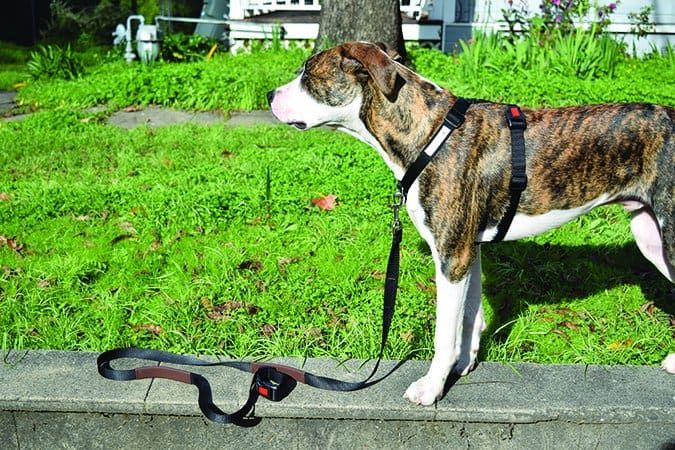For dogs who pull on leash, I have long preferred harnesses over choke chains, prong collars, shock collars, and even flat collars and head halters. Using a harness for dogs instead of a collar has huge benefits. There are many types of dog harnesses out there, and finding the best adult dog or puppy harness might seem like a daunting task. This Whole Dog Journal review of front clip dog harnesses does all of the trial and error work of finding a the best dog harness for you!
When the first dedicated front-clip no-pull harness for dogs (the SENSE-ation Harness) arrived on the market over a decade ago, I was an instant fan of a leash-attachment ring on the harness strap that goes across the front of the dog’s chest. With a properly fitted harness and gentle pressure on the leash (clipped to a ring on the dog’s chest), even a physically challenged handler could turn a pulling dog’s front end back toward her – and reinforce the dog for slacking the leash in this way – helping the dog learn not to pull.
Many other force-free trainers also embraced the new design as a huge improvement over head halters, which were clearly aversive to many dogs. In contrast, most dogs seem to accept the front-clip harness instantly, with only a very small population who seem to find the harness aversive. In my experience, most dogs who object to the harness are sensitive to touch and/or handling, and it’s the process of putting the harness on, rather than wearing the harness, that they object to.
In the years since the SENSE-ation Harness made its debut, an overwhelming number of additional front-clip harnesses have been introduced and an ever-increasing number of people now use these products.
Some owners of dogs who tend to pull on-leash use these harnesses to prevent potential harm from excessive pressure on their dogs’ tracheas. Many others seek out these harnesses primarily for use as management tools that lend a mechanical advantage, allowing a small or physically challenged person to safely walk a hard-pulling dog.
[Editor’s Note: The July 2018 issue of Whole Dog Journal includes a new review of a hands-free leash system that works quite well. For a serious yanker, this product may be an excellent supplement to the no-pull harness while you work on training your dog not to pull.]
As a dog trainer, I’d strongly prefer for owners to learn how to teach their dogs not to pull – but I’m also cognizant that unless an owner feels secure in her ability to control the dog, she will tend to avoid taking the dog out on walks for training. The various types of no-pull dog harnesses provide, in my experience, the least harmful way to give many owners the window of opportunity to reinforce – and thereby train – polite leash walking.
Problems with Front Clip Dog Harnesses
However, given their popularity, and a prevalent lack of attention to proper fit and adjustment, it’s now common to see dogs in obvious discomfort in poorly fit front-clip harnesses that interfere with their movement, even when they are walking without pulling. And some veterinarians and veterinary physical therapists say they have seen an increase in dogs who have suffered injuries or chronic pain from these harnesses.
Fortunately, a number of front-clip harnesses have been developed specifically to address the concerns about the potential physical effects of undue pressure from a harness on a dog’s shoulders, possibly interfering with gait and physical development. With so many new products on the market, we figured it was about time for WDJ to review the broad range of front-clip harnesses currently available. We asked our own clients, fellow trainers, and their clients to recommend their favorite products, and selected the most-recommended dozen to review.
Reviewing the Dog Harnesses
All the harnesses we reviewed work reasonably well to mitigate pulling by putting tension on the front of the dog’s chest; many also offer back-clip options. These products can be used with a leash that has clips at both ends; the handler can use pressure on the back attachment point to guide the dog when she’s not pulling, and control her pressure on the front attachment point if she begins to pull.
All of the harnesses slipped sideways to some degree when pressure was applied, but some slipped significantly more than others, increasing discomfort and chafing for the dog.
In addition, the front straps on some of the products sagged significantly; we found this to be particularly true of the models with straps that cross the dog’s chest horizontally. Reportedly, straps that sag (or are fitted too low) are a major source of injuries to dogs’ forelimb tendons, due to interference with the dog’s natural gait. Sagging chest straps can be reduced to some degree by clipping the leash to the dog’s collar as well as the front ring, but this remedy can reduce the effectiveness of the harness to mitigate the strength of the dog’s pulling.
The harnesses with straps across the shoulders generally do a better job of reducing pulling, but we acknowledge that this advantage may not be enough to offset the concern for physical damage to the dog. At the end of each review, we provided dog harness pros and cons to help you find the best harness for your dog.
Please note: The dog harness reviews on this page are geared toward fully grown dogs. For tips on finding the best device for a puppy, see “Best Puppy Collars & Harnesses“.

Top-Rated Front-Clip Dog Harnesses
Top-Rated Dog Harnesses (4 PAWS)
Our top-rated harnesses all fit well, with minimal sagging, sideways slipping, or gapping of the front strap. These strengths are due to the fact that all three are designed with a Y-shaped chest piece rather than a horizontal strap across the shoulder (the kind that reportedly causes discomfort and injury). All three are easy to put on the dog and are effective in reducing pulling. Despite some marketing claims, none of them “fixed” pulling in “just minutes” – all harnesses require some training in the process in order to truly teach a dog to walk politely on the leash.
Our three top-rated front clip dog harnesses are presented in alphabetical order:
Balance Harness

We like this well-designed, well-made harness a lot. Made by Blue-9 Pet Products, it offers two nice, large rings as attachment points, one in the front and one on the back, and adjusts in six places – more than any of the other products we reviewed. Every single strap that connects one piece of hardware to another adjusts individually: the left and right sides of the neck, the left and right sides of the chest, as well as the straps that connect the “collar” of the harness to the “girth” (one on the back of the dog’s neck and one that goes between his front legs); this enables an owner to get the fit just right.
To put it on the dog, you put the “collar” section over the dog’s head, pass the lower straps through the dog’s front legs, and snap them on both sides to the top strap (which is easy to identify and position, given its contrasting color). It’s super easy.
PROS: Good-quality materials, simple design. Very minimal sideways shifting of chest ring when leash pressure is applied. Girth strap can be adjusted far enough back to be well clear of armpits to avoid chafing.
CONS: Seriously, we were hard-pressed to find anything to criticize one this harness; none.
Front Range Harness

Like all of Ruffwear’s products, their Front Range Harness is very attractive and well made, with heavy-duty hardware and double stitching throughout. It offers two leash-attachments points (front and back) and adjusts in four locations. It’s very easy to put on; just slip the collar section over the dog’s head, draw the straps between his front legs, and click the two long straps into the plastic buckles on either side. The XXS size option makes this the best harness for small dogs we reviewed.
The nylon straps are actually a bit thin, but because so much of the harness is well padded, this should not present a chafing issue. This was the best padded dog harness we reviewed.
We love the two places where a dog’s identifying information can be located: there is a pocket for the dog’s ID tag, and a write-on spot on the inside of the chest piece.
PROS: No straps across the shoulders. Straps adjust easily. Nicely padded for uber-comfort, including padded tabs that insulate the dog’s skin from the plastic buckles to reduce chafing.
CONS: The front ring is small, and looks like a possible weak point; it looks vulnerable to failing due to pressure from a strong-pulling dog.
Perfect Fit Modular Fleece Harness

This harness is the most expensive one we reviewed, but it also may be the best harness for dogs we found – best made, best fitting, and most comfortable.
The Perfect Fit is constructed from three pieces that are chosen individually, based on your dog’s unique measurements. The top, front, and girth pieces clip together to make a complete harness with two connection points, front and back, and five places where the straps can be adjusted. The Perfect Fit harness is perfect for tripod dogs (those who are missing a front limb) because of its modular design.
The harness straps are available in three different widths, from 15 millimeters (a smidge more than half an inch) to 40 millimeters (a little more than 11/2 inches) wide. The bigger the dog you are fitting, the wider the straps you will select. All three pieces that you select for your dog’s harness must be the same width. The top piece is easy to differentiate from the chest piece, as the top is always the colored one. (The black top piece has reflective stitching, so it can’t be confused with a black front piece.)
The Perfect Fit is easy to put on the dog. Just slide the collar section over his head, draw the straps between his front legs, and clip the plastic buckles on each side of his body to the top piece. The harness adjusts easily; the fifth adjustment location, on the strap that connects the “collar” of the harness to the “girth,” helps ensure that the girth can be positioned well behind to elbow to prevent chafing in the armpit.
PROS: Almost the entire harness is lined with soft fleece – not likely to chafe! The modular system allows for custom fitting for dogs of any size.
CONS: Fleece may collect dirt and/or burrs, and may wear easily. At the high end of harness price range.
The Other Front-Clip Dog Harnesses Tested

3-PAW Products
The harnesses that we rated with three paws also fit and functioned well, but either the quality of the materials used in these products was not as high or there were some challenges with straps twisting, making it more difficult to put the harnesses on.
Freedom Harness

This is the highest-rated product with a strap that crosses the dog’s chest and shoulders horizontally. The Freedom Harness has two points of attachment (front and back) and adjusts in four places. Full disclosure: I have been using this harness at my training center for quite some time; it is my favorite of the across-the-shoulder harnesses for fit and quality.
PROS: Made with soft nylon, cross-stitched everywhere, and sturdy hardware. Straps adjust easily. Straps that go under the dog’s “armpits” are velveteen, to prevent chafing. Martingale loop at back leash attachment helps keep harness tight and reduces slipping and gapping.
CONS: Straps go across shoulders. Design allows straps to twist; it can be challenging to untwist.
Walk In Sync Harness

This well-made harness has two leash attachment points and adjusts in five places for a secure fit.
PROS: We like the reflectors on the harness and leash, and the two padded grips on the leash are terrific!
CONS: All one color, along with significant tendency for twisting straps, can make it challenging to put on properly.
2-PAW Products
The following harnesses use cheaper materials and/or have more significant design and/or function flaws.
SENSE-ation Harness

Kudos to Softouch, the company that invented this, the original front-clip harness.
PROS: Simple design, quality materials. Girth strap is a softer (polyester) material for comfort. Straps adjust easily.
CONS: Strap across shoulders. Product literature claims it doesn’t put pressure on the shoulders, but it seems to us that it does. Buckle tends to end up in armpit and rub.
Sure-Fit Harness

Although not marketed as a front-clip harness, the ring located at the chest of this harness can be used as one of two leash attachment points.
PROS: Made with quality materials.
CONS: The fact that this harness is made by a shock collar company (Radio Systems) prevents us from buying and using it. Also, straps twist easily, and solid color, multi-strap design can make it confusing to put on. Fits snugly under armpits and causes the skin to bunch up – could chafe.
TTouch Harmony Harness

There are five places to adjust this harness, and four leash attachment points: one in front and three on the back (two of the latter are sort of a mystery – what are they used for?).
PROS: Lightweight, not bulky. No shoulder strap. Double stitching.
CONS: Straps can easily twist when not on the dog, which can make putting the harness on difficult. Single stitching at non-connection points.
Wonder Walker Body Halter

Two leash-attachment points and four adjustment points. Better quality material than some of the shoulder-pressure models, but with significant gapping and sagging.
PROS: Medium-weight, soft nylon straps, double-stitched, heavy duty hardware. Straps adjust easily.
CONS: Straps go across shoulders, although higher than some harness brands.
Lowest Rated Dog Harnesses (1-PAW)
The following harnesses may offer some utility for some dog owners, but didn’t, in our opinion, possess enough positive features to outweigh factors that we considered a drawback.
DT Universal No-Pull Plus

Dean and Tyler specialize in heavy-duty products for large working dogs, including service animals and those in law enforcement. Most of their products are big, strong, and bulky.
Woody, our model for this article, weights 68 pounds and has a girth measurement of 27 inches. According to the sizing chart, he could wear either a size “small” (which would fit a dog with a 24- to 271/2-inch girth), or a “medium” (which would fit a dog with a 271/2- to 33-inch girth). Given that the product is so bulky, we first selected the size “small” for him, not wanting the larger size to have extra material flapping about and weighing him down. But the smaller size just barely fit; it was just way too snug in every way. We sent it back and got the medium, after all.
The “medium” size product fit better, but the overwhelming feeling we got from this harness was that it really is meant for giant dogs. The straps – and, necessarily, buckles – are very wide. In particular, the strap that goes between the dog’s front legs, would pose a rubbing and chafing hazard. Woody was more or less immobilized by discomfort in this harness; a much larger dog with a thicker coat might wear it without any problem.
The harness has two leash attachment points (front and back), and attachment points on the side of the harness for use when the dog is meant to pull. Wait, what?
This is actually a multi-purpose harness; designed to be used for both pulling (such as carting or sledding) when you attach lines to the rings on either side, and, when you attach a leash to the front attachment point, as a no-pull harness. This is one time when something that works in more than one way is, in our opinion, a drawback rather than an ingenious benefit. We would prefer a dog that does pulling work to wear a harness that’s meant for that purpose alone, and a different harness for the times he’s meant to walk politely without pulling.
PROS: Very sturdy, with two-inch wide heavy-duty nylon, sturdy metal and plastic hardware, double-stitched (some places but not all). Straps adjust easily. It has a nice, nylon, rounded handle on the back for holding onto the dog, and an option for adding a variety of side patches (that attach with a hook-and-loop, Velcro-like fastener) with more than 35 text choices (such as “Service Dog” or “Working Dog”).
CONS: Sides straps cross the dog’s shoulders. Straps bunch when there is pressure on the leash. Definitely too bulky for some dogs.
Easy Walk Harness

This harness is very similar in basic design to the Freedom Harness, SENSE-ation Harness, and Wonder Walker in that it has a girth strap and a strap that crosses the dog’s shoulders horizontally. But whereas the Freedom Harness has a martingale strap across the dog’s back, the Easy Walk has a martingale strap across the chest. That is, the leash-attachment ring rides on a loop of fabric and slides freely from side to side, depending on which side of the dog the leash tension comes from, but which tightens across the dog’s chest when the tension increases.
Note that the black strap is supposed to be the belly strap. However, we found (accidentally) that it fits some dogs better with the belly strap on top.
PROS: Simple design. We love the nifty idea someone had to sew tiny labels inside the straps designating “shoulder,” “chest,” and “belly” to help with putting the harness on the dog properly.
CONS: Chest strap crosses the dog’s shoulders. Considerable sagging and slippage due to the martingale loop in the chest strap. Shoulder strap buckle tends to sit in the dog’s armpit, with potential for chafing. Also, again, this is the product of a shock collar company, and some pet owners (including me) won’t buy products from this company.
Walk Your Dog With Love

This is an interesting product. Its overall design is similar to the others with a single girth strap and a cross-the-chest strap, but it’s a much lighter-weight version with a single leash attachment point and three places (front, top, and bottom) to adjust the fit. It doesn’t seem like it could offer anywhere near the same strength or security of the other products.
PROS: Simple design, straps adjust easily. We like the reflective tabs on the front and sides.
CONS: Chest strap crosses shoulders. Both the nylon straps and plastic buckles and adjustment pieces have a light-duty feel. The front ring sticks out on a long strap, which means you cannot attach the leash to this and to the collar ring to prevent sagging – or rather, you could, but leash tension at that point would pull mostly on the collar, reducing the usefulness of the product’s sole attachment point.
Final Notes
You may have different priorities and preferences and might make difference choices than we did. Most of the harness companies have useful videos and usage instructions on their websites. Check out the companies’ websites for more information before you buy.








Thanks for the article. It is a very informative blog in terms of harness for dogs. The harness gives protection to your dogs. Comfortable dog harness works as the clothes of our pet. They stay protected from dust, cold and other harmful element that may prove dangerous for them.
On the Front Range Harness, you refer to “the front ring” being a possible weak point. If I remember correctly, I thought that when I bought one couple of years ago and returned it. It looks like they’re using a section of nylon webbing now — is that in fact a change from previous front ring, and do you think it’s a stronger attachment than noted in your “Cons” above?
Thank you!
I have been researching for hours trying to make the right choice for my flat coat retriever. I have narrowed it down to the Front Range Harness & the Kurgo Journey Air Harness. I have read several times about the front clip on the Front Range Harness being weak. This is a huge concern for me. Do you have any experience with the Kurgo Journey Air Harness?
Thank you for this article. It was very informative!
Looking to replace a harness, so I read your article to see if there was anything new. Nice to see the Front Range Harness is still among your top. For those of you concerned about the front clip, in all our years of use we never had a problem. Two golden retrievers, 90 and 80 pounds. Both were pretty good walkers, but we could never totally trust either to always pass up every distraction, especially squirrels. Getting ready to purchase another one. The old one is still usable, she just wants a new color. Thanks for the article.
The website description for the Perfect Fit Modular Fleece harness says specifically “The harness is NOT designed for the front D-ring to be used on its own. ” I’ve never gotten used to using a double sided leash, so I want a harness that can be attached just at the front….
I really like the chain at the front of the Wagg Walker harness from Bark Buster’s. It’s the only harness I’ve come across that gives the dog an auditory signal that they are on the verge of the “no-go pull-zone” (my term), and it’s design allows freer shoulder movement than the popular Easy Walk. That noise from the chain is usually enough to make one of us realize that somebody has slowed down or sped up before any tightening/correction is applied. That being said, I see what you mean about where the straps cross certain physical structures. While this harness’ horizontal strap isn’t as low as some of the others you reviewed, I would like to see it higher. I wonder if I can alter the straps somehow… .
A standard harness has its place, and we use them on our three dogs when appropriate. However, front clip harnesses have been problematic as you point out. I purchased your top-rated harness last year; even though it was fitted per the manufacturer’s instructions, it caused my dog to develop a sideways gait and limp. Same thing happened with our older dog 9 years ago, when I bought a similar harness without reading reviews. Just no substitute for proper training – the dog should be able to walk nicely on a leash without a special apparatus. I’m surprised that WDJ is advocating such short cuts.
What kind of pup is Woody? He looks very similar to our rescue pup who we haven’t yet been able to figure out his breed.
I have a young Kelpie
I have no idea what to get
I did by a front attaching harness but can’t get it to fit properly and I’m always worried it may break when he pulls.
Have a normal harness also but not expensive one.
Was wondering if someone could point me in the right direction to find a strong harness either front attached or otherwise
I’d heard great things about the Blue-9 Balance harness so I ordered one for a new dog I adopted in December. Measured once, measured twice very carefully to be sure I got the right size.
Long story short, it doesn’t fit. I’ve adjusted every strap possible but even with the front chest strap adjusted to it’s shortest length there’s a huge gap in the strap that makes it useless as a no pull harness and very impractical for walking a dog that doesn’t pull. So no help whatsoever for training a dog to walk without pulling.
I have 3 dogs who according the Blue-9’s fitting guidelines all measure for a Medium harness. It only fits one of them, the largest of the 3. Too loose and, again, therefore useless for 2 of them.
To make matters worse, their customer service is terrible. I paid shipping for a harness that doesn’t fit – not though any fault of mine – and I’d have had to pay shipping *again* to return it. Absolutely no consideration from Blue-9 for the fact that I didn’t just order the wrong size and that it doesn’t fit 2 of the 3 dogs that it should have.
I think it’s probably a great harness for dogs that it fits, but unless you have an opportunity to try it on the dog first to make sure it works, you’ll end up getting no help from Blue-9 Products and spending quite a bit of money for shipping both ways with no harness to show for it in the end. :O(
Another con: It’s pretty darn hard to even get the harness on a dog that’s all squirmy. So many connection points make it very inconvenient IMO.
Thanks for this article. very great and informative for dog harness.